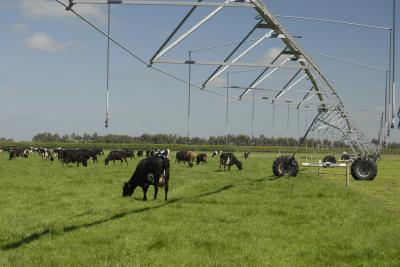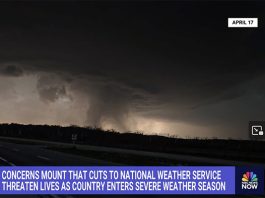
This article is an excerpt from the Grazing Lands Conservation Initiative publication “Extending Your Grazing Season and Reducing Stored Feed Needs” by Dr. Don Ball, Auburn University, Ed Ballard, University of Illinois Extension, Mark Kennedy, State Grazing Lands Specialist, NRCS, Missouri, Dr. Garry Lacefield, University of Kentucky, and Dr. Dan Undersander, University of Wisconsin-Madison. We’ll be sharing more excerpts in future issues.
Pastures often become unproductive or go dormant in mid- to late summer due to lack of water. Irrigation may relieve the situation, but before proceeding with this alternative, landowners should thoroughly consider all the issues that contribute to irrigation system cost:
■ Is there an inexpensive source of water available? Water sources vary greatly in cost, so this should be carefully checked. During hot weather, some plants require approximately 0.25 to 0.30 inches per day. Check with a knowledgeable irrigation specialist for water requirements in your area. One inch on one acre is 27,158 gallons, so the water supply must be able to supply a minimum of 7,000 to 8,000 gallons per acre per day(after evaporation and other losses) to be effective for irrigating any field or pasture.

■ Pumping from streams frequently requires a permit from the U.S. Army Corps of Engineers and/or the state agency or regional water district responsible for natural resources. If irrigation is desired by a certain time, there should be an assessment as to how long it will likely take to acquire permits and install equipment. Permit time can be up to 12 months, depending on the on-site physical situation.
■ Will irrigation of pastures be cost effective? The quantity and value of forage produced on average must be enough to justify installing the system plus the expense of operating it. Typically, irrigation must be used hundreds of hours each year for many years to be economical.

■ Irrigation equipment application efficiency should be considered. Newer pivot irrigation equipment may have 85% or higher efficiency (% of water pumped that is made available to plant), but older systems, particularly traveling guns, may only be 60% efficient. Lower efficiency means more water and more pumping energy is needed to get water application rates and yield responses compa- rable to higher efficiency systems.
■ Labor to operate irrigation equipment should be considered. Pivot irrigation systems are the least labor intensive at about 0.0125 hour per acre. Traveling gun or tow irrigation systems may need ten times that (about 0.15 hour per acre).
■ With irrigation automatically comes the need for balanced and often increased fertilization. Irrigating malnourished pastures is a waste.
■ In some areas, soil types, or situations, soil compaction caused by the hooves of grazing animals (which is greatly intensified when soil is wet) or eventual soil salinization may be a concern.
If these issues can be resolved, pasture irrigation may be a consideration, but it should be a long-term commitment, not a “knee-jerk” reaction to one or two years of drought.

Forages respond to irrigation at any vegetative stage. The yield increase is linear to the total water applied up to the amount needed by the plant for daily growth. The critical question is whether the extra pasture forage that may be produced on average will be worth the cost. An effective pasture irrigation system is generally not much less expensive per acre than an effective row crop irrigation system.
Need more about grazing on irrigated pasture? Dave Scott of ATTRA did a great series last summer. Here are links to the articles in this series:
Intensive Grazing on Irrigated Pastures
Setting Up an Intensive Grazing System That Works – Pasture Rest Periods
Paddock Grazing Periods in Irrigated Pastures
Putting It All Together – Or Calling the Dance





It is quickly obvious when they talk about water use, even without looking at the list, that the authors are from humid regions.
In the western and Southern Great Plains, potential water use by native short-grasses may use 0.25 to 0.3 inches/day in late spring. In the heat of summer, that approaches or exceeds 0.5 inches/day, though water is seldom available to meet the potential water use. Potential water use is greater for improved-grass or mixed-grass pastures which have greater biomass production.
The efficiency of biomass production decreases as one moves from the northern Great Plains (cooler mean temperature) to the Southern Great Plains (warmer mean temperature), and as one moves from the tall-grass prairies (greater precipitation and relative humidity = less evaporative demand) west to the short-grass prairies (less precipitation and lower relative humidities = greater evaporative demand).
In semiarid and arid regions, irrigation dramatically increases biomass production. However, biomass production for hay or grazing livestock systems is seldom the most profitable use of irrigation water.
All other comments apply to any region, except the potential for getting water from streams. As precipitation decreases as one moves west, streams become fewer and farther apart; most are ephemeral. If present, aquifers become the water source for irrigation since precipitation in most semiarid regions is insufficient to support groundwater, except near perennial rivers.
Perhaps you could provide a disclaimer at the beginning of the article that narrows the scope of application.
Clay Robinson, PhD
Certified Professional Soil Scientist
Former Professor of Soil Science
Comments are closed.